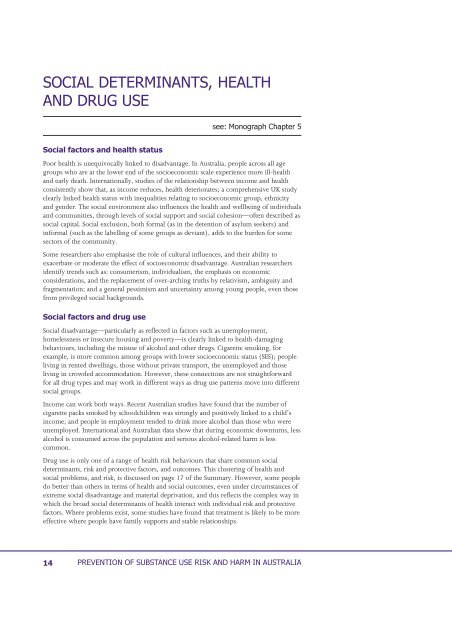Summary - Department of Health and Ageing
Summary - Department of Health and Ageing
Summary - Department of Health and Ageing
Create successful ePaper yourself
Turn your PDF publications into a flip-book with our unique Google optimized e-Paper software.
Poor health is unequivocally linked to disadvantage. In Australia, people across all age<br />
groups who are at the lower end <strong>of</strong> the socioeconomic scale experience more ill-health<br />
<strong>and</strong> early death. Internationally, studies <strong>of</strong> the relationship between income <strong>and</strong> health<br />
consistently show that, as income reduces, health deteriorates; a comprehensive UK study<br />
clearly linked health status with inequalities relating to socioeconomic group, ethnicity<br />
<strong>and</strong> gender. The social environment also influences the health <strong>and</strong> wellbeing <strong>of</strong> individuals<br />
<strong>and</strong> communities, through levels <strong>of</strong> social support <strong>and</strong> social cohesion—<strong>of</strong>ten described as<br />
social capital. Social exclusion, both formal (as in the detention <strong>of</strong> asylum seekers) <strong>and</strong><br />
informal (such as the labelling <strong>of</strong> some groups as deviant), adds to the burden for some<br />
sectors <strong>of</strong> the community.<br />
Some researchers also emphasise the role <strong>of</strong> cultural influences, <strong>and</strong> their ability to<br />
exacerbate or moderate the effect <strong>of</strong> socioeconomic disadvantage. Australian researchers<br />
identify trends such as: consumerism, individualism, the emphasis on economic<br />
considerations, <strong>and</strong> the replacement <strong>of</strong> over-arching truths by relativism, ambiguity <strong>and</strong><br />
fragmentation; <strong>and</strong> a general pessimism <strong>and</strong> uncertainty among young people, even those<br />
from privileged social backgrounds.<br />
<br />
Social disadvantage—particularly as reflected in factors such as unemployment,<br />
homelessness or insecure housing <strong>and</strong> poverty—is clearly linked to health-damaging<br />
behaviours, including the misuse <strong>of</strong> alcohol <strong>and</strong> other drugs. Cigarette smoking, for<br />
example, is more common among groups with lower socioeconomic status (SES); people<br />
living in rented dwellings, those without private transport, the unemployed <strong>and</strong> those<br />
living in crowded accommodation. However, these connections are not straightforward<br />
for all drug types <strong>and</strong> may work in different ways as drug use patterns move into different<br />
social groups.<br />
Income can work both ways. Recent Australian studies have found that the number <strong>of</strong><br />
cigarette packs smoked by schoolchildren was strongly <strong>and</strong> positively linked to a child’s<br />
income; <strong>and</strong> people in employment tended to drink more alcohol than those who were<br />
unemployed. International <strong>and</strong> Australian data show that during economic downturns, less<br />
alcohol is consumed across the population <strong>and</strong> serious alcohol-related harm is less<br />
common.<br />
Drug use is only one <strong>of</strong> a range <strong>of</strong> health risk behaviours that share common social<br />
determinants, risk <strong>and</strong> protective factors, <strong>and</strong> outcomes. This clustering <strong>of</strong> health <strong>and</strong><br />
social problems, <strong>and</strong> risk, is discussed on page 17 <strong>of</strong> the <strong>Summary</strong>. However, some people<br />
do better than others in terms <strong>of</strong> health <strong>and</strong> social outcomes, even under circumstances <strong>of</strong><br />
extreme social disadvantage <strong>and</strong> material deprivation, <strong>and</strong> this reflects the complex way in<br />
which the broad social determinants <strong>of</strong> health interact with individual risk <strong>and</strong> protective<br />
factors. Where problems exist, some studies have found that treatment is likely to be more<br />
effective where people have family supports <strong>and</strong> stable relationships.

















